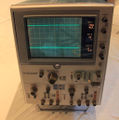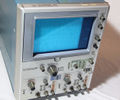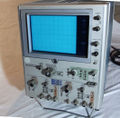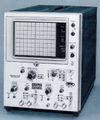5030: Difference between revisions
No edit summary |
No edit summary |
||
| Line 31: | Line 31: | ||
{{Spec | X input | 20 mV/Div to 500 mV/Div on Ext Horizontal, or Channel 2 in X-Y mode}} | {{Spec | X input | 20 mV/Div to 500 mV/Div on Ext Horizontal, or Channel 2 in X-Y mode}} | ||
{{Spec | CRT | 8 × 10 Div @ 1.27 cm (0.5"), P31 phosphor }} | {{Spec | CRT | 8 × 10 Div @ 1.27 cm (0.5"), P31 phosphor }} | ||
{{Spec | Acceleration | 4 kV }} | {{Spec | Acceleration voltage | 4 kV }} | ||
{{EndSpecs}} | {{EndSpecs}} | ||
Revision as of 08:21, 21 January 2022
The Tektronix 5030 is a dual-beam oscilloscope that was introduced in 1969 (no longer listed in the 1973 catalog). There is a portable benchtop model, the 5030, and a rack-mount version, the R5030. The sister model 5031/R5031 is an almost identical (analog) storage scope.
The 5030s feature differential inputs on both channels, with additional inputs for 125-turn probes (P6021 or P6019). Input ranges are similar to the contemporary 3A9 diff/current amplifier plugin but without the variable bandwidth and DC offset controls. The horizontal deflection system is shared.
The 5031/5030 include a readout system which uses small lightbulb/fiber dot matrix displays external to the CRT, similar to that in the 576 curve tracer. Only the first and last steps on the time/div and volts/div switches are labelled.
Key Specifications
| Bandwidth | DC to 1 MHz (5 kHz limit switchable) |
|---|---|
| Deflection | 10 μV/Div to 10 V/Div or 1 mA/Div to 200 mA/Div (1—2—5) |
| Noise | < 15 μV / 200 μA |
| Input impedance | 1 MΩ // 50 pF |
| Time base | 1 μs/Div to 5 s/Div (1—2—5), magnifier up to × 50 |
| CMRR | 100,000:1 to 100 kHz |
| X input | 20 mV/Div to 500 mV/Div on Ext Horizontal, or Channel 2 in X-Y mode |
| CRT | 8 × 10 Div @ 1.27 cm (0.5"), P31 phosphor |
| Acceleration voltage | 4 kV |
Links
Pictures
-
-
-
-
-
-
-
-
-
-
-
-
5030 (catalog image)
-
R5030
-
Display detail (5031)
-
Detail of fiberoptic readout module
-
-
-
-
Schematics
-
Sweep schematic



















